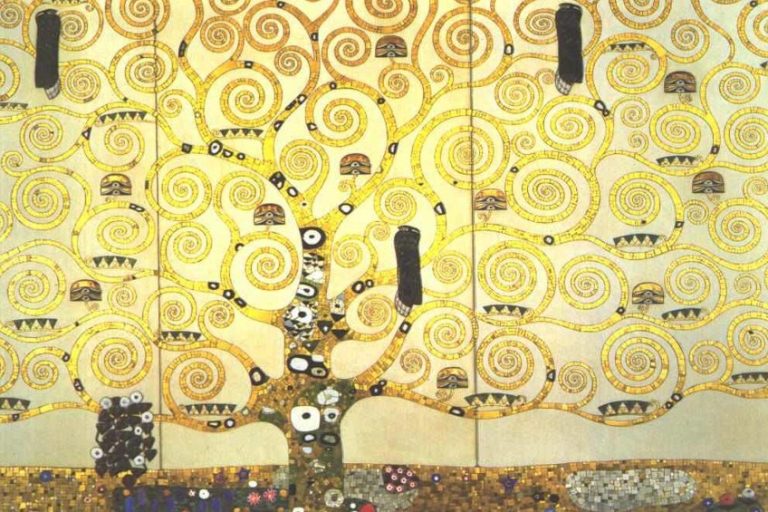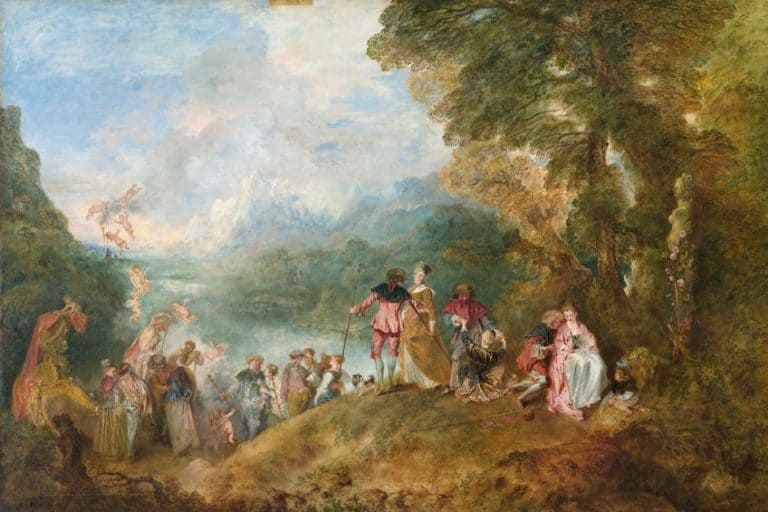“Nude Descending a Staircase” – Discover Duchamp’s Nudity Painting
Imagine a painting of a nude descending a staircase, but only, this nude looks more robotic and calculated rather than robust and curvaceous, as nudes in art history are expected to be. Charged with a sort of kineticism, this person is a moving force of lines and shapes. This is the painting we will explore in the article below, titled Nude Descending a Staircase (1912) by Marcel Duchamp.
Table of Contents
Artist Abstract: Who Was Marcel Duchamp?
Henri-Robert-Marcel Duchamp was born on July 28, 1887, in Northern France in Normandy. He died on October 2, 1968, reportedly from heart failure. His parents and siblings were all artistic and he learned from his older brother Jacques Villon (Gaston Duchamp). He started with drawings and watercolors from a young age, eventually progressing to painting.
In 1904, he started studying at the Académie Julian in Paris. He was acquainted with artists like Francis Picabia and the writer Guillaume Apollinaire.
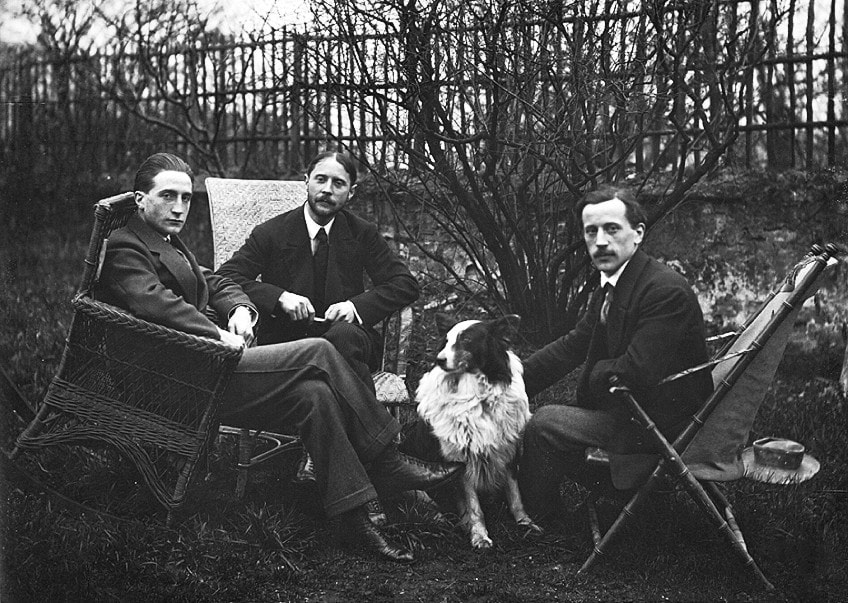
He was interested in the Cubism art styles and was part of groups like the Section d’Or or the Puteaux Group. He moved to the United States in 1915. He later left the art world and became involved in playing chess.
Duchamp was a significant influence on 20th-century art and influenced art styles from Minimalism to Pop Art. He was unconventional and expressed his ideas through a wide range of media beyond the traditional paint on canvas.
Nude Descending a Staircase (No.2) (1912) by Marcel Duchamp in Context
| Artist | Henri-Robert-Marcel Duchamp |
| Date Painted | 1912 |
| Medium | Oil on canvas |
| Genre | Abstract, Figurative, and Non-representational |
| Period / Movement | Cubism, Cubo-Futurist |
| Dimensions | 151.8 x 93.3 centimeters |
| Series / Versions | N/A |
| Where Is It Housed? | Philadelphia Museum of Art, United States |
| What It Is Worth | It was purchased by Frederic C. Torrey in 1913 for $324, then purchased by Walter Arensberg in 1919 for $1000, and donated to the Philadelphia Museum of Art in 1950. |
Below we will look at one of the most famous nudity paintings from 20th-century Modern art, Marcel Duchamp’s Nude Descending a Staircase (No.2). We will start with a brief contextual analysis, giving a little bit more information about how this painting became a “succès de scandale” and its placement as Cubo-Futurist.
This will be followed by formal analysis, exploring the subject matter in greater detail and Marcel Duchamp’s artistic approaches and influences. We will look at various art elements like color, texture, line, form, shape, space, and so forth.
Contextual Analysis: A Brief Socio-Historical Overview
The Nude Descending a Staircase (No.2) painting has often been described as a “succès de scandale” (“success of scandal”) because of its unconventionality of representation, especially its representation of a nude; the European and American art worlds shunned it in in their own ways based on their perceptions of art and what it should look like.
The time was the early 1900s, 1912 to be exact, and in Europe and America, this was the burgeoning 20th-century Modern art world. Perceptions around representation were changing and evolving, but Marcel Duchamp’s rendition of a nude descending a staircase was something different.
During 1912, Duchamp sought to exhibit at the Société des Artistes Indépendants, otherwise known as the Salon des Indépendants, in Paris. This exhibition eventually did not show his painting, but it was featured in the catalog as number “1001”.
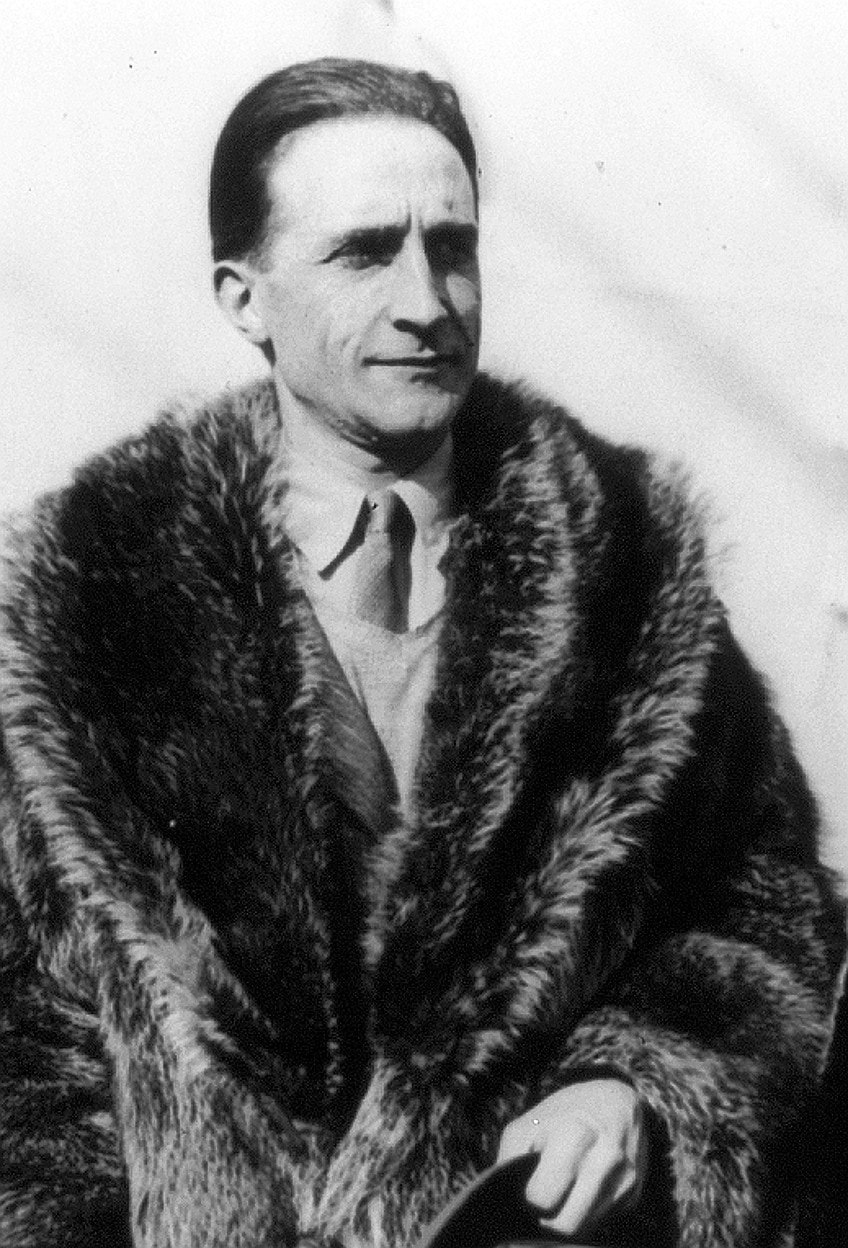
Reportedly, the fellow Cubist Albert Gleizes requested that Duchamp’s brothers ask him to remove the painting, more specifically, to remove the title in the bottom left corner. It was written as “NU DESCENDANT UN ESCALIER”. The reasons for this have been based on questions around whether the painting should’ve been hung with Cubist artworks.
Marcel Duchamp reportedly removed his painting after this request was made and when interviewed, stated that he took his painting “home in a taxi”. This was also an eye-opening experience for him, and he also stated that he would “not be very much interested in groups after that”.
Consequently, Duchamp’s nude was exhibited in Barcelona in 1912 at the art gallery called Galeries Dalmau. The exhibition was titled “Exposició d’Art Cubista”. It also traveled to America, where it was exhibited in New York City at the Armory Show in 1913, which showcased various avant-garde artworks from European artists. The Armory Show was organized by Walter Pach, who took several of Duchamp’s paintings in 1912 for the show.
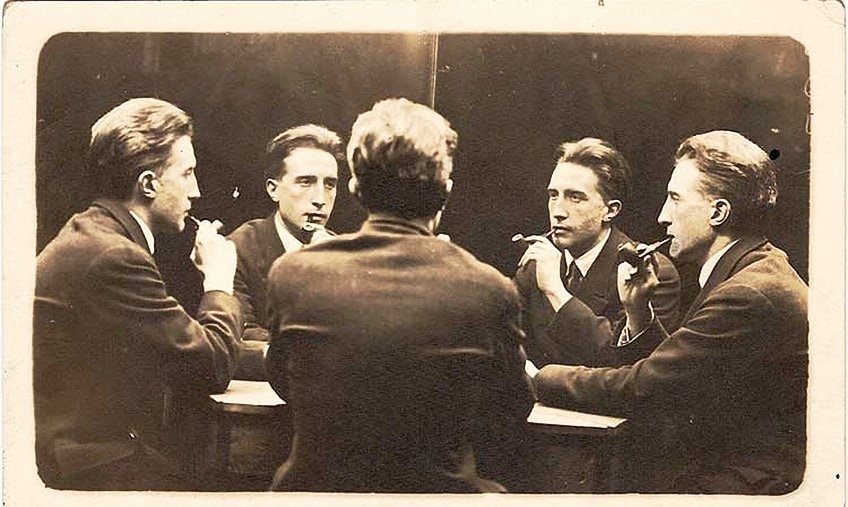
Duchamp’s infamous nudity painting apparently received varied responses when it was exhibited, and the artist had made a name for himself without being there in person. Additionally, his paintings were all sold. In Pierre Cabanne’s publication Dialogues With Marcel Duchamp (1971), Duchamp explained that when Pach returned to Paris in 1914 he invited Duchamp to America.
When the artist arrived in New York he realized that he “wasn’t a stranger at all”. He also realized that although people knew about the painting, they did not know him, there was “no connection between the painting and me”, he explained. Reportedly this occurred for several decades.
In the same interview with Cabanne, Duchamp mentioned why the painting was scandalous for its time. Along with the title causing significant interest, he said, “One just doesn’t do a nude woman coming down the stairs, that’s ridiculous”. He further explained that when the painting was “new” it “seemed scandalous” because “a nude should be respected” and that it was “offensive on the religious, Puritan level”.
Bridging the Gap Between Cubism and Futurism: A Cubo-Futurist Nude
It is important to note that Nude Descending a Staircase (No.2) was a painting between two art styles, so to say, namely Cubism and Italian Futurism. The latter started around 1909 and explored dynamic motion in art, aspects like speed and movement were portrayed by artists.
There was a move away from old art and a celebration of technology and the new modern world.

Some of the techniques utilized to achieve the effects of motion were through art principles like repetition, which also created a rhythm. Artists were also influenced by Cubism, which started around 1907. Cubism was famous for its fractured picture planes, utilizing lines, shapes, and forms to create geometrically- charged spaces. A characteristic difference between Cubism and Futurism was movement. Cubists would often portray their subject matter as “static” where Futurists would depict movement.
Duchamp’s “Nude Descending a Staircase” seemingly bridges the gap between Cubism and Futurism in that we see the characteristic fracturing of form coupled with the dynamism of the moving subject matter.
We Must Not Forget Photography
Another contributing influence on Duchamp’s artistic style was photography, especially the work of Eadweard J. Muybridge, who became famous for capturing the subtle consecutive movement in humans and animals.
The photograph, “The Horse in Motion (“Sallie Gardner”, Owned by Leland Stanford: Running at a 140 Gait over the Palo Alto Track, 19th June, 1878)” (1878), is a famous example is from his experiment to prove that all a horse’s hooves leave the ground when it gallops. This was a study for Leland Stanford, who was a businessman and horse breeder.
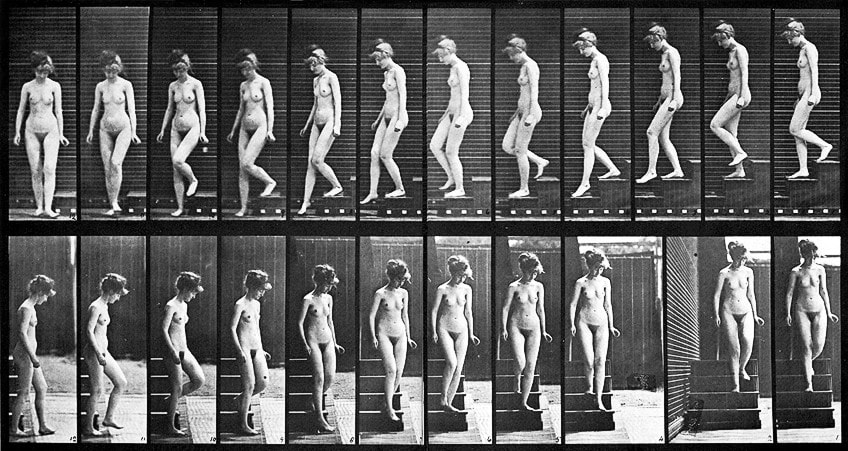
Another influence may have been the physiologist Étienne-Jules Marey, he utilized chronophotography to study and record movement, otherwise referred to as locomotion. This was considered a precursor to cinematography.
An interesting fact is that Muybridge produced numerous prints depicting his subjects in the process of movement, some were also of nude women, examples include, Plate Number 34. Walking and carrying a 15-lb. basket on head, hands raised (1887) and Women Walking Down Steps (1887).
The latter undoubtedly contributed to Duchamp’s painting of his nude descending a staircase.
A Title That Says It All: Is It a Female Nude?
Marcel Duchamp painted the title in the lower-left corner of Nude Descending a Staircase which, as we mentioned above, reads “NU DESCENDANT UN ESCALIER”. However, the French term nu, which means “naked”, is the masculine form of the word.

This has raised debates around the gender of the figure – is it a female nude, or is it a man descending stairs? Was it Duchamp’s intention to fragment the gender as much as the picture plane to create more universality in the composition and its meaning?
We automatically connect the idea of the nude to the feminine because the nude has predominantly been portrayed by women throughout art history.
Formal Analysis: A Brief Compositional Overview
Below, we will take a closer look at how Marcel Duchamp depicted his Nude Descending a Staircase (No.2). Based on the above-mentioned influences, we are given a better understanding of the stylistic elements involved in how the subject matter was portrayed.
Visual Description: Subject Matter
If we look quickly at Duchamp’s Nude Descending a Staircase (No.2) it is possible that we will not understand what we are seeing. An immediate interpretation of this composition could consist of lines, various shapes, and a general sense that this is a robot?
However, as we continue to look at this painting, the form comes into clearer focus, almost like how a photograph’s image develops in a dark room, slowly showing the subject matter. This is a woman walking down a staircase, as the title also assists in our understanding of the subject.
There appears to be more than one woman, but this depicts Duchamp’s study of motion and time-lapse imagery. Starting from the left we see the walking figure move towards the right of the composition, becoming larger in form as she/he approaches nearer to us in the foreground. We can see the shapes of stairs in the bottom left corner.
As we move more towards the upper left of the painting we will see the continuous curving of the stairs in the background, which seemingly reaches all the way to the top right corner of the composition, out of our view.
Color
The color scheme in Nude Descending a Staircase (No.2) consists of mostly neutral colors, otherwise also referred to as a monochromatic color palette. These are mostly tones of ocher, browns, blacks, and subtle tones of blues.
This choice of color was a characteristic trait of Cubism and famous artists like Pablo Picasso and others.
They utilized monochromatic colors so that there would be more focus on form, eliminating any possible distraction that could come with a varied assortment of colors. The figure in the foreground is depicted in lighter hues compared to the background, which Duchamp depicted in darker colors, providing a contrasting effect.
It is almost as if there is an unknown light source on the figure, as she approaches the front, she becomes lighter.
Texture
The texture of the paint is visible on the Nude Descending a Staircase (No.2) canvas and there is an expressive application to the paint, in other words, we can see where the paint is applied and go over the lines. It is not rushed, but rather open and fluid.
Furthermore, there is a smooth implied texture of the figure, coupled with the geometric shape of the body, we can almost see a resemblance to a robot and its shiny surface and geometric body.
Line, Form, and Shape
Lines are a large part of Nude Descending a Staircase, in fact, it gives the painting its character. The figure provides strong vertical linearity to the composition, which is seemingly contrasted by the shorter horizontal lines from the winding staircase.
If we look closer, there are multitudes of curved, short, long, thin, and thick lines all playing their part to create a rhythm and sense of motion as the figure descends the staircase.
This is further emphasized by the curved white dots near the center of the figure’s hip area, possibly suggesting rotation, as well as wisps of curved lines near the figure’s lower legs. There are also different shapes and forms at play here, from circular and square shapes to more three-dimensional cylindrical and convex forms that suggest the figure’s upper torso and legs. The figure’s lower legs and feet appear more pyramidal and cubic in form.
An interesting example of how Duchamp conveyed fragmented forms is in the lower-left corner. We can deduce that these are stairs, they become more uniform in their horizontality in the distance, but in the foreground, they almost become a muddled mix of curves, and the more we look at them, the more our brain tries to discern them as stairs.
Space
The figure is the primary aspect of the spatial area, this is also referred to as “positive space”. The receding stairs create a three-dimensional feel to the composition, coupled with the figure which also becomes larger in scale in the foreground.
This creates spatial depth.
However, the picture plane is a geometric playground, an experiment of shapes and forms creating repetition and rhythm suggesting motion and dynamism. This also heightens the overall unity of the composition.
Fragments of Form Coming into Focus
Marcel Duchamp’s nudity painting was critiqued as an “explosion of a shingle factory” by the writer and reported Julian Street and the American President Theodore Roosevelt compared it to his Navajo bathroom rug, the latter was a “far more satisfactory and decorative picture”. He also commented on the title as a man descending stairs and provided a similar, tongue-in-cheek title for his rug, “A Well-Dressed Man Going Up a Ladder”.
For Duchamp’s “Nude Descending a Staircase (No.2)”, we must look beyond what our imagination immediately refers to from our preconceived ideas about the human figure, and more specifically the idea of the nude. This was a painting that did not represent reality – although there are figurative traces – but rather motion through geometry. We are urged to look between the lines and discard any preconceived notions so that the form can take shape.
Frequently Asked Questions
Who Painted Nude Descending a Staircase?
Marcel Duchamp, who was born in France, painted Nude Descending a Staircase (1912). The painting has often been described as Cubo-Futurist, portraying aspects from both art styles.
Where Is the Painting Nude Descending a Staircase?
Marcel Duchamp’s painting Nude Descending a Staircase (1912) is located at the Philadelphia Museum of Art in the United States. It was donated to the museum around the 1950s by the Arensberg family.
What Made Nude Descending a Staircase (No.2) So Popular?
Marcel Duchamp portrayed the figure of the nude in a wholly different manner compared to how it has been portrayed in art. He fragmented the nude into geometric pieces versus the naturalism of how nudes were traditionally portrayed. This was an example of avant-garde Modern art that viewers were not accustomed to, and it was considered scandalous.
Alicia du Plessis is a multidisciplinary writer. She completed her Bachelor of Arts degree, majoring in Art History and Classical Civilization, as well as two Honors, namely, in Art History and Education and Development, at the University of KwaZulu-Natal, South Africa. For her main Honors project in Art History, she explored perceptions of the San Bushmen’s identity and the concept of the “Other”. She has also looked at the use of photography in art and how it has been used to portray people’s lives.
Alicia’s other areas of interest in Art History include the process of writing about Art History and how to analyze paintings. Some of her favorite art movements include Impressionism and German Expressionism. She is yet to complete her Masters in Art History (she would like to do this abroad in Europe) having given it some time to first develop more professional experience with the interest to one day lecture it too.
Alicia has been working for artincontext.com since 2021 as an author and art history expert. She has specialized in painting analysis and is covering most of our painting analysis.
Learn more about Alicia du Plessis and the Art in Context Team.
Cite this Article
Alicia, du Plessis, ““Nude Descending a Staircase” – Discover Duchamp’s Nudity Painting.” Art in Context. May 18, 2022. URL: https://artincontext.org/nude-descending-a-staircase/
du Plessis, A. (2022, 18 May). “Nude Descending a Staircase” – Discover Duchamp’s Nudity Painting. Art in Context. https://artincontext.org/nude-descending-a-staircase/
du Plessis, Alicia. ““Nude Descending a Staircase” – Discover Duchamp’s Nudity Painting.” Art in Context, May 18, 2022. https://artincontext.org/nude-descending-a-staircase/.






